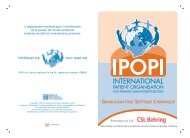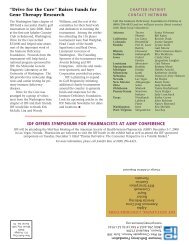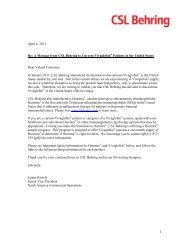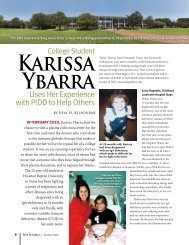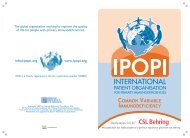IDF Patient & Family Handbook for Primary Immunodeficiency ... - IDFA
IDF Patient & Family Handbook for Primary Immunodeficiency ... - IDFA
IDF Patient & Family Handbook for Primary Immunodeficiency ... - IDFA
Create successful ePaper yourself
Turn your PDF publications into a flip-book with our unique Google optimized e-Paper software.
Hyper IgM Syndrome 43<br />
Definition of Hyper IgM Syndrome<br />
<strong>Patient</strong>s with Hyper IgM (HIM) syndrome have<br />
an inability to switch production of antibodies<br />
of the IgM type to antibodies of the IgG, IgA, or<br />
IgE type. As a result, patients with this primary<br />
immunodeficiency disease have decreased levels<br />
of serum IgG and IgA and normal or elevated<br />
levels of IgM. B-lymphocytes can produce<br />
IgM antibodies on their own, but they require<br />
interactive help from T-lymphocytes in order to<br />
switch antibody production from IgM to IgG, IgA<br />
and IgE. The hyper IgM syndrome results from a<br />
variety of genetic defects that affect this interaction<br />
between T-lymphocytes and B-lymphocytes.<br />
The most common <strong>for</strong>m of hyper IgM syndrome<br />
results from a defect or deficiency of a protein that is<br />
found on the surface of activated T-lymphocytes.<br />
The affected protein is called “CD40 ligand”<br />
because it binds to a protein on B-lymphocytes<br />
called CD40. CD40 ligand is made by a gene<br />
on the X-chromosome. There<strong>for</strong>e, this primary<br />
immunodeficiency disease is inherited as an<br />
X-linked recessive trait and usually found only<br />
in boys. As a consequence of their deficiency in<br />
CD40 ligand, affected patients’ T-lymphocytes are<br />
unable to instruct B-lymphocytes to switch their<br />
production of immunoglobulins from IgM to IgG,<br />
IgA and IgE. In addition, CD40 ligand is important<br />
<strong>for</strong> other T-lymphocyte functions, and there<strong>for</strong>e,<br />
patients with X-linked hyper IgM syndrome (XHIM)<br />
also have a defect in some of the protective<br />
functions of their T-lymphocytes.<br />
Other <strong>for</strong>ms of HIM syndrome are inherited as<br />
autosomal recessive traits (see chapter titled<br />
Inheritance) and have been observed in females<br />
and males. The molecular bases <strong>for</strong> some of the<br />
other <strong>for</strong>ms of HIM have been discovered. These<br />
<strong>for</strong>ms of HIM syndrome result from defects in<br />
the genes that are involved in the CD40 signaling<br />
pathway. Genetic defects in CD40 are very rare<br />
and have been described in few families. The<br />
resulting disease is almost identical to XHIM<br />
because although the CD40 ligand is present on<br />
T-lymphocytes, the CD40 found on B-lymphocytes<br />
and other cells of the immune system is either not<br />
present or does not function normally. Two other<br />
genes (AID and UNG) have been identified that<br />
are necessary <strong>for</strong> B-lymphocytes to switch their<br />
antibody production from IgM to IgG, IgA or IgE.<br />
Defects in both of these genes have been found<br />
in patients with HIM syndrome. Since the function<br />
of these genes is limited to antibody switching,<br />
the other T-lymphocyte functions of CD40 ligand<br />
are not affected, and these patients are less likely<br />
to have infections caused by organisms that are<br />
controlled by T-cells.<br />
Finally, a defect in another X-linked gene that<br />
is necessary <strong>for</strong> the activation of the signaling<br />
molecule NF-qB has been identified in a <strong>for</strong>m<br />
of HIM that is associated with a skin condition<br />
called ectodermal dysplasia. <strong>Patient</strong>s have<br />
immunodeficiency with sparse hair and conical<br />
teeth among other abnormalities. NF-qB is<br />
activated by CD40 and is necessary <strong>for</strong> the<br />
signaling pathway that results in antibody<br />
switching. NF-qB is also activated by other<br />
signaling pathways that are important in fighting<br />
infections. There<strong>for</strong>e, these affected boys are<br />
susceptible to a variety of serious infections.<br />
Clinical Presentation of Hyper IgM Syndrome<br />
Most patients with Hyper IgM (HIM) syndrome<br />
develop clinical symptoms during their first or<br />
second year of life. The most common problem<br />
is an increased susceptibility to infection including<br />
recurrent upper and lower respiratory tract<br />
infections. The most frequent infective agents<br />
are bacteria. A variety of other microorganisms<br />
can also cause serious infections. For example,<br />
Pneumocystis jiroveci (carinii) pneumonia, an<br />
opportunistic infection, is relatively common during<br />
the first year of life and its presence may be the<br />
first clue that the child has the X-linked <strong>for</strong>m of<br />
HIM syndrome (XHIM). Lung infections may also<br />
be caused by viruses such as Cytomegalovirus<br />
and fungi such as Cryptococcus. Gastrointestinal<br />
complaints, most commonly diarrhea and<br />
malabsorption, have also been reported in<br />
some patients. One of the major organisms<br />
causing gastrointestinal symptoms in XHIM is<br />
Cryptosporidium that may cause sclerosing<br />
cholangitis, a severe disease of the liver.<br />
Approximately half of the patients with XHIM<br />
syndrome develop neutropenia (low white blood<br />
cell count), either transiently or persistently. The<br />
cause of the neutropenia is unknown, although<br />
most patients respond to treatment with the








